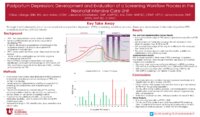The Graduate Nursing Project collection includes Doctor of Nursing Practice (DNP) Scholarly Projects and Master's students' non-thesis projects submitted as part of program requirements.
TO
Filters: Relation Is Part Of: "Graduate Nursing Project, Doctor of Nursing Practice, DNP, Neonatal" Collection: "ehsl_gradnu"
| Title | Creator | Date | Description | Relation Is Part Of | ||
|---|---|---|---|---|---|---|
| 1 |
 |
Quality Improvement Project: The Development of a Feeding Guideline for Neonates with Gastroschisis | Newton, Adriana | 2023 | Background: Gastroschisis is the most common abdominal wall defect treated in the neonatal intensive care unit (NICU). Well-defined standardized gastroschisis guidelines, multidisciplinary team collaboration during guideline development, and sufficient guideline directives regarding feeding progress... | Graduate Nursing Project, Doctor of Nursing Practice, DNP, Neonatal |
| 2 |
 |
De-implementing the Routine Measurement of Gastric Residual Volumes in an All-Referral Newborn Intensive Care Unit | Tucker, Erin B. | 2023 | Background: Routine gastric residual volume measurement has historically been the standard of care in many neonatal intensive care units to monitor for feeding intolerance and necrotizing enterocolitis. However, current evidence suggests that gastric residual volume is a poor indicator of these path... | Graduate Nursing Project, Doctor of Nursing Practice, DNP, Neonatal |
| 3 |
 |
The Creation and Implementation of a Neonatal Palliative Care Toolkit | Warren, Charise; Bierer, Ryan; Hamilton, Jennifer | 2023 | Background: According to the March of Dimes (2020), the infant mortality rate in Salt Lake County, Utah was 5.4 per 1,000 live births, with 69% of these infant deaths occurring during the neonatal period. Advances in perinatal medicine have led to increased identification of fetuses with fatal or li... | Graduate Nursing Project, Doctor of Nursing Practice, DNP, Neonatal |
| 4 |
 |
The Creation and Implementation of a Neonatal Palliative Care Toolkit | Warren, Charise; Bierer, Ryan; Hamilton, Jennifer | 2023 | POSTER | Graduate Nursing Project, Doctor of Nursing Practice, DNP, Neonatal; Poster |
| 5 |
 |
Postpartum Depression: Development and Evaluation of a Screening Workflow Process in the Neonatal Intensive Care Unit | LaBerge, Chloe C.; Anker, Jenn; Hearne, Jenny | 2023 | Background: Postpartum depression (PPD) is the most common complication of childbirth. Typically, screening for PPD is performed in the immediate postpartum period, followed by interval screening at the pediatrician office during well child visits. Within the general population, about 10-15% of moth... | Graduate Nursing Project, Doctor of Nursing Practice, DNP, Neonatal |
| 6 |
 |
Postpartum Depression: Development and Evaluation of a Screening Workflow Process in the Neonatal Intensive Care Unit | LaBerge, Chloe C.; Anker, Jenn; Hearne, Jenny | 2023 | POSTER | Graduate Nursing Project, Doctor of Nursing Practice, DNP, Neonatal; Poster |
| 7 |
 |
Increasing Utilization of Extended-Dwell Peripheral Intravenous Catheters in the Neonatal Intensive Care Unit: A Quality Improvement Project | Shepherd, Laura | 2023 | Background: Repeated pain exposure in neonates is often associated with decreases in long-term cognitive and motor outcomes. Peripheral intravenous (PIV) catheterization attempts are a common source of pain. PIVs need to be replaced frequently given the nature of neonatal peripheral blood vessels. E... | Graduate Nursing Project, Doctor of Nursing Practice, DNP, Neonatal |
| 8 |
 |
End-of-Life Self-Efficacy Initiative for Advanced Practice Providers in the NICU | Trimm, M. Rhiannon | 2022 | Background: End-of-life care is ever-present in the newborn intensive care unit, with approximately 5% of neonatal patients in the United States requiring end-of-life care annually. A scarcity of educational resources currently exists with little to no formal training offered to advanced practice pr... | Graduate Nursing Project, Doctor of Nursing Practice, DNP, Neonatal |
| 9 |
 |
Evaluating the Effectiveness of an Existing Late Onset Sepsis Tool in a Culture-positive Patient Subgroup at a Level III Newborn Intensive Care Unit | Valadez, Marta G.; Hardin, Pamela | 2022 | Background: Late-onset sepsis is an overwhelming systemic response to a bacterial, viral, or fungal infection and a leading cause of neonatal morbidity and mortality. The Surviving Sepsis Campaign has recommended each unit have a systematic sepsis screening process. Implementing a screening approach... | Graduate Nursing Project, Doctor of Nursing Practice, DNP, Neonatal |
| 10 |
 |
Implementation of Ultrasound Use for Vascular Access in the Newborn ICU | Nickels, Joshua D.; Chan, Belinda; Schiefelbein, Julieanne | 2022 | Background: Peripheral intravascular access (PIV) is one of the most common procedures in the Newborn Intensive Care Unit (NICU). However, it is common for neonates to undergo multiple attempts before successful PIV placement can be achieved. Ultrasound-Guided intravenous placement (USG-IV) has been... | Graduate Nursing Project, Doctor of Nursing Practice, DNP, Neonatal |
| 11 |
 |
Necrotizing Enterocolitis Toolkit: Quality Improvement in the Neonatal Intensive Care Unit | Hartvigson, Julee G. | 2022 | Background: Necrotizing Enterocolitis (NEC) is a devastating illness in the neonatal population. Despite decades of research, the pathology of NEC is not fully understood, and 90% of incidences occur in premature neonates. It is unclear if healthcare providers are aware of the risk factors that plac... | Graduate Nursing Project, Doctor of Nursing Practice, DNP, Neonatal |
| 12 |
 |
Decreasing day to first skin-to-skin holding in Infants <30 Weeks | Hardy, Rachael; Hardin, Pamela | 2022 | Background: According to the CDC (2020) 1 out of every 10 pregnancies in the United States will result in a pre-term birth. Continued advancement of neonatal care has led to an increase in survival rates for these very preterm infants. Skin-to-skin (STS) holding has been widely studied and demonstra... | Graduate Nursing Project, Doctor of Nursing Practice, DNP, Neonatal |
| 13 |
 |
Bedside Oxygen Histogram Monitoring in the NICU for Infants at Risk for Retinopathy of Prematurity | Arslanian, Lindsay A.; Hamilton, Jennifer L. | 2022 | Background: Retinopathy of prematurity (ROP) is a vaso-proliferative disease process that is exclusive to premature infants and can be exacerbated by supplemental oxygenation administration. Infants that experience hypoxia and hyperoxia are at an increased risk of developing severe ROP. Bedside oxyg... | Graduate Nursing Project, Doctor of Nursing Practice, DNP, Neonatal |
| 14 |
 |
Implementation of The CDC's Developmental Milestone Guideline for Infants Corrected Age 2-4 Months Hospitalized in the NICU | Hall, Catherine A. | 2022 | Background: Every year in the United States there are approximately 360,000 babies that are born premature. In the state of Utah that number is approximately 45,700, which is almost 10% of all babies born. Preterm infants are at greater risk for developmental delays. Long lengths of stay in the Newb... | Graduate Nursing Project, Doctor of Nursing Practice, DNP, Neonatal |
| 15 |
 |
Placental Lab Draws in the Newborn ICU: A Quality Improvement Project | Evans, Ida Katrina; Hamilton, Jennifer | 2022 | Background: Obtaining an infant's labs from the placenta on admission is a relatively new practice in the Newborn Intensive Care Unit (NICU). This practice decreases phlebotomy losses, reduces blood transfusions, reduces iatrogenic blood loss, and decreases exposure to pain. There is a lack of stand... | Graduate Nursing Project, Doctor of Nursing Practice, DNP, Neonatal |
| 16 |
 |
Evaluation of the Parent Experience with Home Enteral Feeding Tubes in Infants Discharged from the Newborn Intensive Care Unit | Mitchell, Megan I. | 2022 | Background: Infants who spend time in the Newborn Intensive Care Unit must attain full oral feedings prior to discharge. Waiting for a clinically stable infant to attain full oral feedings can considerably increase their time spent in the hospital. Allowing these infants to discharge home with a fee... | Graduate Nursing Project, Doctor of Nursing Practice, DNP, Neonatal |
| 17 |
 |
Prioritizing Family-Centered Care in a Level IV NICU:Development and Implementation of a Skin to Skin Care Bundle | Harbison, Lauren | 2022 | Background: Skin to skin care (SSC), also known as kangaroo care, is the practice of placing a mostly undressed infant onto the bare chest of a parent, where they can be held for an extended period. Evidence shows that SSC provides many benefits to infants and their parents, particularly for the hig... | Graduate Nursing Project, Doctor of Nursing Practice, DNP, Neonatal |
| 18 |
 |
Prevention of Hypothermia at Delivery in Infants Born Preterm, at 28 to 34 Weeks Gestation, Through Implementation of a Clinical-Workflow Process | Rowley, Denise O. | 2022 | Background: According to the March of Dimes, 10% of infants born nationally in 2021 were born prematurely, at less than 37 weeks. In Utah, 1% of infants are born prematurely each year, between 28 and 34 weeks. Worldwide, hypothermia at delivery occurs at a rate of 30% to 90% among infants delivered ... | Graduate Nursing Project, Doctor of Nursing Practice, DNP, Neonatal |
| 19 |
 |
Optimizing time to treatment for Hypoxic Ischemic Encephalopathy (HIE) for Transported Neonates | DeLaney, Kathryn; Hamilton, Jennifer; Baserga, Mariana; DuPont, Tara | 2021 | Background: Most infants requiring therapeutic hypothermia (TH) therapy for Hypoxic Ischemic Encephalopathy (HIE) are born at facilities without therapeutic capabilities. There is a narrow timeframe for initiating TH, necessitating prompt identification, transport, and initiation of therapy. Quali... | Graduate Nursing Project, Doctor of Nursing Practice, DNP, Neonatal |
| 20 |
 |
Optimizing time to treatment for Hypoxic Ischemic Encephalopathy (HIE) for Transported Neonates | DeLaney, Kathryn; Hamilton, Jennifer; Baserga, Mariana; DuPont, Tara | 2021 | Background: Most infants requiring therapeutic hypothermia (TH) therapy for Hypoxic Ischemic Encephalopathy (HIE) are born at facilities without therapeutic capabilities. There is a narrow timeframe for initiating TH, necessitating prompt identification, transport, and initiation of therapy. Quali... | Graduate Nursing Project, Doctor of Nursing Practice, DNP, Neonatal |
| 21 |
 |
Implementation of a Probiotic Protocol at an Urban Level 3 NICU | Halford, Tami | 2020 | Background: Necrotizing enterocolitis (NEC) is a common cause of morbidity and mortality among premature and low birth weight infants. Infants who suffer from NEC are at increased risk for death and other poor outcomes, including problems associated with prolonged parenteral nutrition, long-term gas... | Graduate Nursing Project, Doctor of Nursing Practice, DNP, Neonatal |
| 22 |
 |
Education on Appropriate Infant Positioning In the NICU | Bodamer, Peggy | 2020 | Background:Infant positioning plays a vital role in the development of neonates. Inappropriate positioning of premature infants born at less than 34 weeks' gestation increases the risk of developing positional non-synostotic head deformities (NHD) and non-congenital ear deformities (NCED). Bedside p... | Graduate Nursing Project, Doctor of Nursing Practice, DNP, Neonatal |
| 23 |
 |
Are Placental Blood Samples a Proxy for Infant Blood Samples When Comparing Lab | Vance, McKenna | 2020 | Background: Neonatal anemia is a common problem faced by infants admitted to the NICU. Admission labs to the NICU typically required 3-4 mL of blood for diagnostic purposes. Blood losses from phlebotomy draws increases the likelihood of anemia in preterm infants less than 32 weeks gestation and may ... | Graduate Nursing Project, Doctor of Nursing Practice, DNP, Neonatal |
| 24 |
 |
Implementation of a Minimal Stimulation Guideline for Infants Less than 29 Weeks Gestation for the First Week of Life | Orr, Jennifer | 2020 | Background:The prevalence of prematurity is significant, with 1 in 8 live births occurring before 37 weeks gestation. More infants are surviving who are born between 22-28 weeks gestation. These infants are at high risk for adverse neurodevelopmental outcomes. Steps taken during the first week of li... | Graduate Nursing Project, Doctor of Nursing Practice, DNP, Neonatal |
| 25 |
 |
Exploring the Role of the Neonatal Nurse Practitioner Beyond the NICU | Yilaire, Renee Y. | 2020 | Background: The Neonatal Intensive Care Unit (NICU) graduate is at an increased risk of morbidities and mortality after discharge from the acute care setting of the NICU. The lack of experienced healthcare providers with specialized training and knowledge of the NICU graduate creates gaps in follow-... | Graduate Nursing Project, Doctor of Nursing Practice, DNP, Neonatal |
